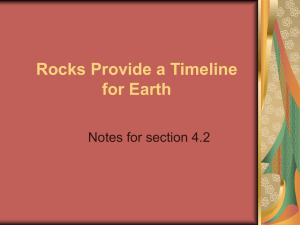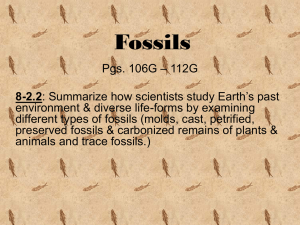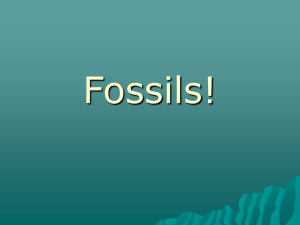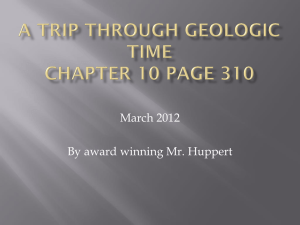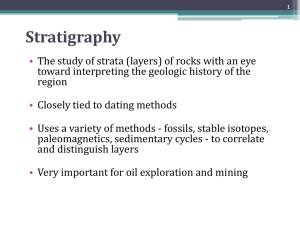Chapter 5
advertisement
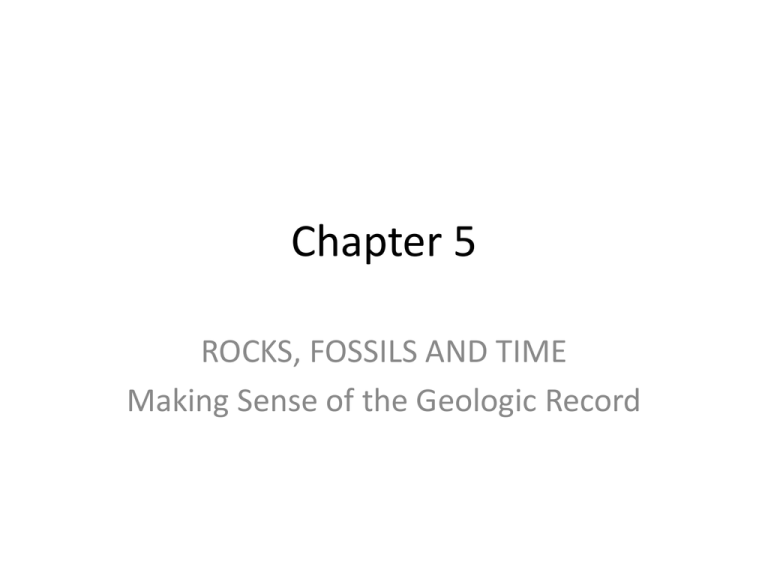
Chapter 5 ROCKS, FOSSILS AND TIME Making Sense of the Geologic Record Stratigraphy The branch of geology called stratigraphy is concerned with the composition, origin, age relationships, and geographic extent of sedimentary rocks, Vertical Stratigraphic Relationships In vertical successions of sedimentary rocks, surfaces known as bedding planes separate individual strata from one another (Figure 5.1), The rocks below and above a bedding plane differ in composition, texture, color, or a combination of these features, indicating a rapid change in sedimentation or perhaps a period of nondeposition and/or erosion followed by renewed deposition Relative Ages • Superposition ? • Principle of Inclusions? • Unconformities? Relative Age Examples Relative Age Example Lateral Relationships—Facies • Rock layers may terminate abruptly where they abut the edge of a depositional basin, where they are eroded, or where they are cut by faults. A rock unit may also become progressively thinner until it pinches out, or it splits laterally into thinner units each of which pinches out—a phenomenon known as intertonguing. And finally, a rock unit might change by lateral gradation as its composition and/or texture become increasingly different Both intertonguing and lateral gradation indicate the simultaneous operation of different depositional processes in adjacent environments. Deposition in each of these laterally adjacent environments yields a sedimentary facies, a body of sediment with distinctive physical, chemical, and biological attributes. • Armanz Gressly, in 1838, was the first to use the term facies when he carefully traced sedimentary rocks in the Jura Mountains of Switzerland and noticed lateral changes such as sandstone grading into shale. He reasoned that these changes indicated deposition in different environments that lie next to one another Marine Transgressions and Regressions Three rock units exposed in the walls of the Grand Canyon of Arizona consist of sandstone followed upward by shale and finally limestone (Figure 5.7). These three facies, all with fossils of marine-dwelling trilobites and brachiopods, were deposited on one another. Marine Transgressions and Regressions Extent, Rates and Causes of Marine Transgressions and Regressions • • • Six major marine transgressions followed by regressions have taken place in North America since the Neoproterozoic, yielding unconformity-bounded rock sequences that provide the stratigraphic framework for our discussions of Paleozoic and Mesozoic geologic history Shoreline movements during transgressions and regressions probably amount to no more than a few centimeters per year. Suppose that a shoreline moves landward 1000 km in 20 million years, giving 5 cm/yr as the average rate of transgression. Our average is reasonable, but we must point out that large-scale transgressions are not simply events during which the shoreline steadily moves landward. In fact, they are characterized by a number of reversals in the overall transgressive trend, thus accounting for the intertonguing we see among some sedimentary rock units Geologists agree that uplift and subsidence (downward movement) of the continents, the amount of water frozen in glaciers, and rates of seafloor spreading are responsible for marine transgressions and regressions. During uplift of a continent, the shoreline moves seaward, and just the opposite takes place during subsidence. Widespread glaciers expanded and contracted during the pennsylvanian Period, which caused several sea level changes and resulted in transgressions and regressions. Indeed, if all of Earth’s presentday glacial ice were to melt, sea level would rise by about 70 m. Cratonic Sequences Examples Epeiric sea Western interior seaway Fossils and Fossilization The solution to this problem involves using fossils, if present, and some physical events of short duration such as volcanic ash falls. Fossils: the remains or traces of prehistoric organisms preserved in rocks most common: in sedimentary rocks, but they may also be found in volcanic ash and volcanic mudflows Geologist uses for : • Relative ages • Determining environments of deposition • Part of the evidence for the theory of evolution. Body Fossils: Bones, teeth and shell • Body Fossils: are preserved body parts. Favorable conditions for preserving body fossils are that an organism has durable skeleton and lives where rapid burial is likely. Corals, clams, and brachiopods have good fossil record example of a poor record : jelly fish Bats have skeleton but are very delicate they live where burial is not so likely. Body Fossils continued • Body Fossils can be preserved in different ways: In some cases the body parts remain unchanged and are simply preserved as they existed. These are called Unaltered Body Fossils How: freezing, mummification, entrapment in a thick fluid, such as tar tree sap, which hardens into amber Body Fossils continued • • Unaltered remains retain their original composition and structure Altered remains or Altered Body Fossils: the remains maybe changed through a chemical process, preserving the shape of the body part but not its original composition Altered remains are preserved in three basic ways: • Replacement: Replacement fossilization occurs when an organism (usaully the hard parts, such as shell or bone) are buried in sediments, dissolved and replaced by new minerals. • Permineralization: Preservation by permineralization occurs when minerals seep into open spaces of buried remains, such as bones, or wood, but leave some of the original organic in place. • Carbonization: Some organic materials, such as leaves or insects, can be preserved as carbon film. This preservation results when all that remains of the original organism is a thin film of carbon preserving its shape. • The most common type of fossil preservation is in the form of a mold or a cast • Mold: a mold forms when an organism buried in sediments, the sediments are hardened into rock and the remains of the organism decay or dissolve away. Cast: When sediments fill in the cavity of a shell or bone and harden , presserving the iner details of the body part. • Altered remains of Organisms Just passing through: Trace Fossils Some fossils provide evidence of an animal’s activity in a distant past with out preserving any part of the organism itself. Are also called ichnofossils or trace fossils, because the organism only left a trace or a small indicator, of its life and behavior. Trace fossils are any preserved indication of an organism's activity • Burrows: burrows indicate how an organism lived. Small burrows ocean-dwelling organisms, for example are easily preserved in the soft sediments at the bottom of the sea. • • Tracks and trails: Organisms that move across land or along the ocean bottom may leave footprints, tracks, and trails in the sediment. They may be buried and become trace fossils indicating movement and motion. Coprolites: coprolites are fossilized droppings or feces, from an organism. Types of Fossil Preservation Fossils and Telling Time William Smith (1769–1839), an English civil engineer who was surveying and building canals in southern England, independently discovered Steno’s principle of superposition. He reasoned that in a sequence of strata, the oldest is at the bottom and the youngest is at the top, and he came to the same conclusion regarding any fossils the rocks contained. Smith made numerous observations at outcrops, mines, and quarries and discovered that the sequence of fossils, and especially groups of fossils, is consistent from area to area. In short, he discovered that the relative ages of sedimentary rocks at different locations could be determined by their fossil content Correlation In geology, the term correlation refers to matching up geologic phenomena in two or more areas. For example, we may simply correlate the same rock units, with no regard to time, over an area in which they are no longer continuous, in which case we refer to lithostratigraphic correlation. In a previous section, we noted that systems were identified beyond their stratotype areas by applying the principle of fossil succession. In this case, we match up rocks of the same relative age, which is a time- stratigraphic correlation. Correlation Correlation

